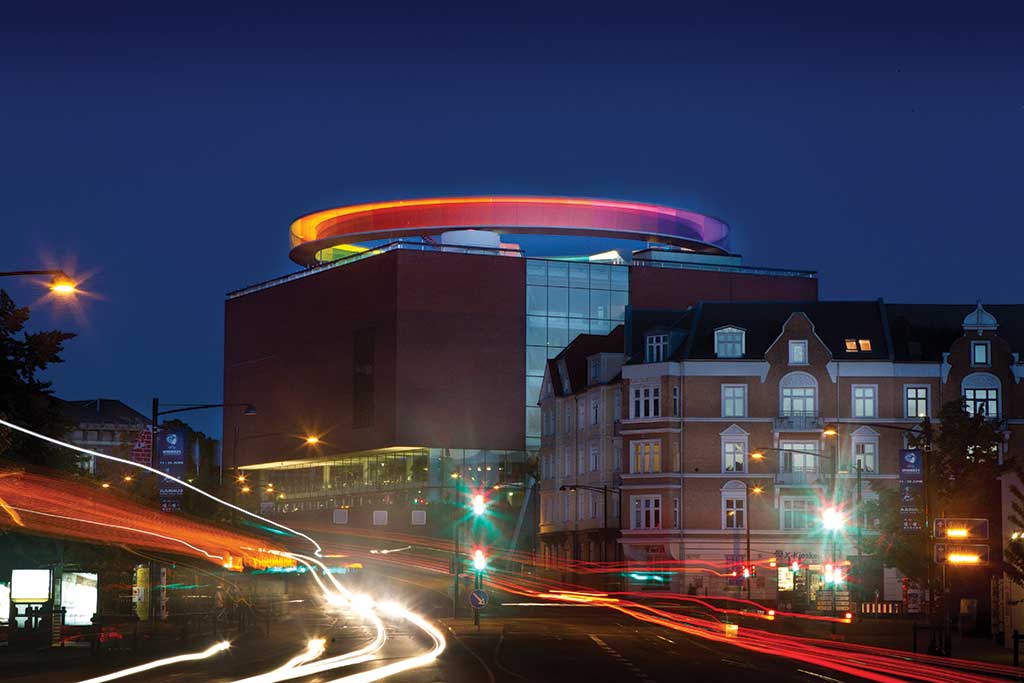Whether it’s a rainbow of revelry during Pride, or a cornucopia of cuisine and culture that has elevated Aarhus to international acclaim, a jaunt to Jutland is a must to make your next journey to Denmark complete.
Denmark has long appealed to those who appreciate modern design, timeless fashion, New Nordic cuisine, and hygge, an ubiquitous sense of coziness that seems to permeate Danish culture whether it’s the dark days of winter or a bright summer afternoon on the Jutland peninsula. Most are familiar with Copenhagen’s enticing cultural offerings, but scoop around Denmark’s archipelago to the northwest via rail (or boat, if you want to take a longer, scenic route), and you’ll discover Aarhus (www.visitaarhus.com), one of Scandinavia’s oldest cities.
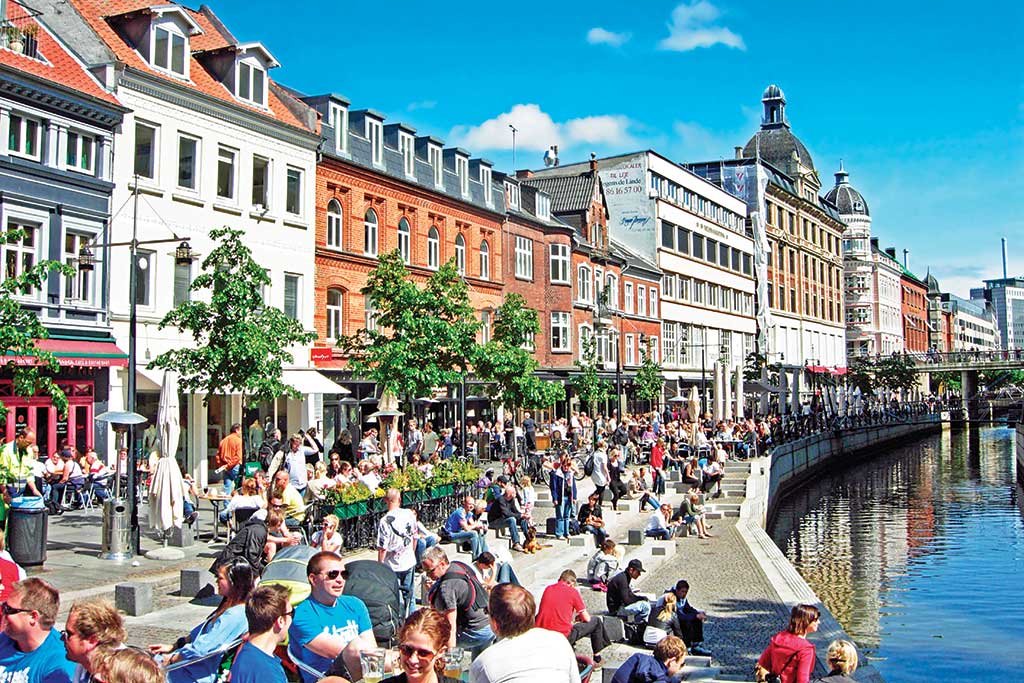
Aarhus Town Center
Founded during the Viking Age, recently discovered archeological evidence indicates that Aarhus dates back to around 770. Today, the city boasts a population of approximately 300,000, with a youthful vibe due to Aarhus University. Established in 1928, it’s one of the most prestigious public universities in the world, and with a student population nearing 45,000, it certainly tips the scale in terms of the millennial demographic.
While Copenhagen’s older sibling has in the past shied away from the limelight while the country’s capital acquired accolades and Michelin stars, this year marks a dramatic shift for Aarhus. The city was named 2017’s European Capital of Culture (www.aarhus2017.dk/en). With a hefty investment of € 5,760,000 ($6.2 million), Aarhus is in the midst of a dynamic cultural phenomenon, encompassing four MEGA events throughout the year as well as 12 Full Moon events. More than 350 artistic and cultural projects are on the program, overseen by Aarhus 2017 Foundation Chief Executive Rebecca Matthews.
“‘Rethinking’ is the narrative throughout our program of transformative, exciting cultural experiences, [which] will showcase how art and culture can be a catalyst for change in our lives and our society,” commented Matthews. “A year that is original, radical, rooted, and relevant.”
While the year is packed with events, two not-to-miss happenings include Watermusic (www.watermusic.randers.dk), September 2-3, a large-scale multimedia musical event that will take place in the Randers industrial harbor. Featuring international singer Oh Land, English dance company Motionhouse, and a 300-person choir, the massive undertaking will mystically explore the themes of water that have permeated Aarhus for centuries. Art and history lovers should also seek out Image Storm, a collective exhibition that will appear at the Museum of Religious Art, the Women’s Museum, and the Skovgaard Museum. The exhibition commemorates the 500th anniversary of the Reformation and will include more than 150 provocative works of art that explore themes of censorship, religion, sexuality, politics, and ethnicity (October 1–December 30).
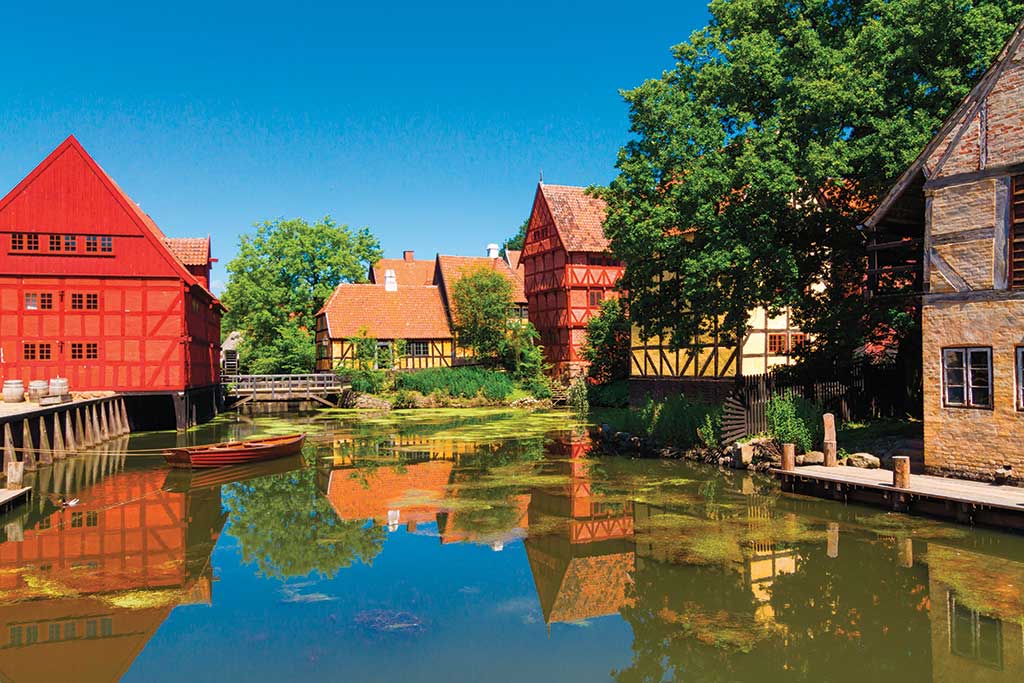

The old village in Aarhus By Raymond Thill
No matter what time of year, ARoS Aarhus Kunstmuseum (Aros Allé 2. Tel: +45-8730-6600, www.en.aros.dk) is at the city’s cultural epicenter. Dating back to 1859, ARoS has continued to grow, both in terms of its physical exhibition space as well as its collection, which now includes more than 8,700 works of art ranging from paintings and sculptures to art videos, photography, and more. This year, the museum presents its first-ever triennial, titled “THE GARDEN – End of Times; Beginning of Times.” The exhibit explores humankind’s ever-evolving relationship with nature. Also on display through January 2018 is “No Man is an Island – The Satanic Verses.” Featured artists include one of the museum’s landmark sculptures, “Boy” by Ron Mueck. At nearly 15 feet tall and 1,100 pounds, it took Mueck eight months to create the hauntingly realistic fiberglass sculpture. Don’t miss ARoS’s rooftop walkway, “Your Rainbow Panorama,” which has become the city’s calling card. Constructed from 400 tons of Italian glass, the spectacular structure took 18 months to install and has become one of Aarhus’s most photographed locales.
With more than 1,200 years of evolution under its belt, Aarhus has plenty to offer the history buff, and in typically Danish fashion, it’s delivered in an aesthetic package that will even amuse those more interested in aquavit than Vikings. The Moesgaard Museum (Moesgaard Allé 15. Tel: +45-8739-4000. www.moesgaardmuseum.dk/en) dynamically tells the story of Denmark’s past including the Stone Age, Bronze, Iron, and Viking Ages. The museum’s new home opened in 2014 and represents the perfect synergy of its contents with the natural surroundings. Designed by Henning Larsen Architects, the museum is built into the landscape with a sloped grass roof, which at its peak offers views of the Bay of Aarhus. Its interior, much of it left raw, features fiber concrete, Nordic stone, dark-stained ash, and pops of color in red, orange, and pink.
Of course, it’s what is inside the museum that draws visitors from far and wide, many of them descending on the museum for a peek at the Grauballe Man, the world’s best-preserved bog body. Discovered in 1952, the corpse dates back to the third century and, due to the bog’s unique chemical composition, remains nearly intact and offers insights into life during the Iron Age. Other highlights include the largest collection of Roman weapons in the world as well as The Evolution Stairs, which feature reconstructed human species from throughout time from 3.2-million-year-old Lucy to acclaimed physicist Stephen Hawking.
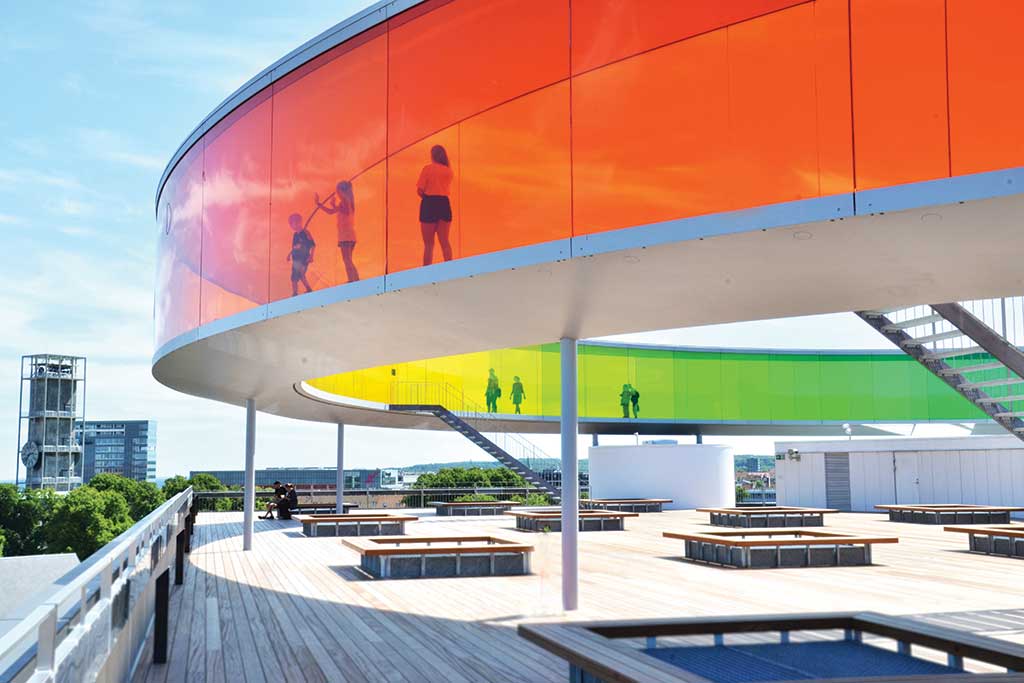

ARoS Aarhus Kunstmuseum, Your Rainbow Panorama
For a stroll through how Aarhus has evolved through the centuries, head to Den Gamle By, The Old Town Museum (Viborgvej 2. Tel: +45-86123188. www.dengamleby.dk/engelsk/the-old-town). Denmark’s national open-air museum of urban history and culture showcases more than 75 houses that have been relocated from throughout the country. Divided into three sections, visitors can walk the cobblestone streets reminiscent of the days of Denmark’s most famous author, Hans Christian Andersen. Discover trade workers and authentic specialty shops like the Bakery on Algade, where hindbærsnitte (a shortbread cookie layered with raspberry jam and finished with a sugar glaze) is the confection of choice. The 1920’s section marks the influx of industrialization, including Schou’s Soaphouse, while the 1974 neighborhood showcases Denmark’s progressive evolution with the inclusion of a commune, Poul’s Radio and TV Shop, and the hole-in-thewall Jazzbar Bent J, where you can still grab a pint and hear live music.
Any visit to Aarhus isn’t complete without time spent on the water. The Viking’s original settlement was a strategic move due to the harbor’s positioning as a trade port, but it wasn’t until the harbor’s major expansion was complete in 1861, and the opening of the region’s first railway line that Aarhus became a veritable force in Denmark’s economy.
Today, the most unique way to experience the water is with Aarhus Sea Rangers (Hack Kampmanns Plads 1, 4.sal. Tel: +45-7216-1995. www.searangers.dk). Using military-grade RIB (rigid-inflatable boat) vessels, participants suit up in heavy-duty, waterproof gear and skip along the open water at exhilarating speed. The working harbor exemplifies Aarhus’s industrial prowess, while the architecturally stunning residential development, Isbjerget (The Iceberg), anchors the city’s newest neighborhood, Aarhus Ø (Aarhus East). Exploring by land, be sure to visit the quarter’s Ø-Haven city garden, observation tower, and nearby Navitas Science and Innovation building for another example of architectural innovation.
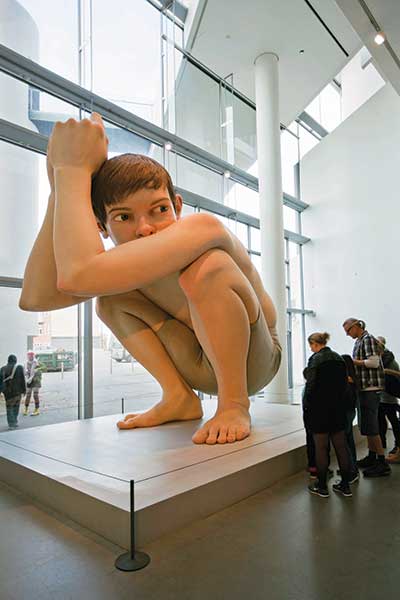

“Boy” by Ron Mueck at ARoS Aarhus Kunstmuseum photo By Lisaveya
Aarhus is pedestrian-friendly with easy landmarks like Aarhus Central Station to the south, the harbor to the east, and the Aarhus River bisecting the city center. Strøget is a half-mile, carfree street where shoppers will find mainstream brands, but veer off in any direction and you’re bound to discover local shops with more unique offerings. The Latin Quarter dates back to the 14th century and retains Old World charm where you can find terrific local shops and curated wares with that oh-so-Danish sensibility. Standouts include Støy (Store Torv 4, Tel: +45-4195-5444. www.stoy.com/en) where you’ll find international labels; Lertøj (Badstuegade 4. Tel: +45-8619-2712. www.lertoj.dk) for locally made pottery; or venture a few blocks west to 1 + 1 Textil & Design (Grønnegade 41. Tel: +45-7020-1042. www.1x1textil.dk) for beautiful soft furnishings that will bring the hygge into your home.
Wandering the streets will demand a requisite coffee break and there’s no better place to enjoy a cup than in Denmark, which ranks number seven in the top coffee-consuming nations of the world. Perhaps one of the few subjects that will ruffle a Dane’s feathers, coffee connoisseurs are notoriously subjective in their loyalty, but two favorites often rise above the competition. La Cabra Coffee Roasters’ (Graven 20. www.lacabra.dk) minimalist setting provides the backdrop for perhaps the most quintessential cortado (half espresso, half warm milk, no foam) you’re ever likely to drink. Roasting their own beans, La Cabra only works with socially conscious importers to source exquisite beans such as Pinheirnho from Brazil and Munyinya from Burundi, East Africa. La Cabra also runs a limited-production bakery out of the basement of their Graven location, where you can feast on tangy sourdough and other delights.
The aptly named Great Coffee (Klostergade 32 H. Tel: +45-2849-8323. www.greatcoffee.dk), helmed by founder, certified roaster, and lead barista Søren Stiller Markussen, attracts lines out the door, and local rumors claim that the strong-headed Markussen has been known to refuse or kick out customers for attempting to order some chain-store concoction, though a recent visit yielded none of the aforementioned histrionics, just a fantastic cup of coffee worth the trip to Aarhus alone.
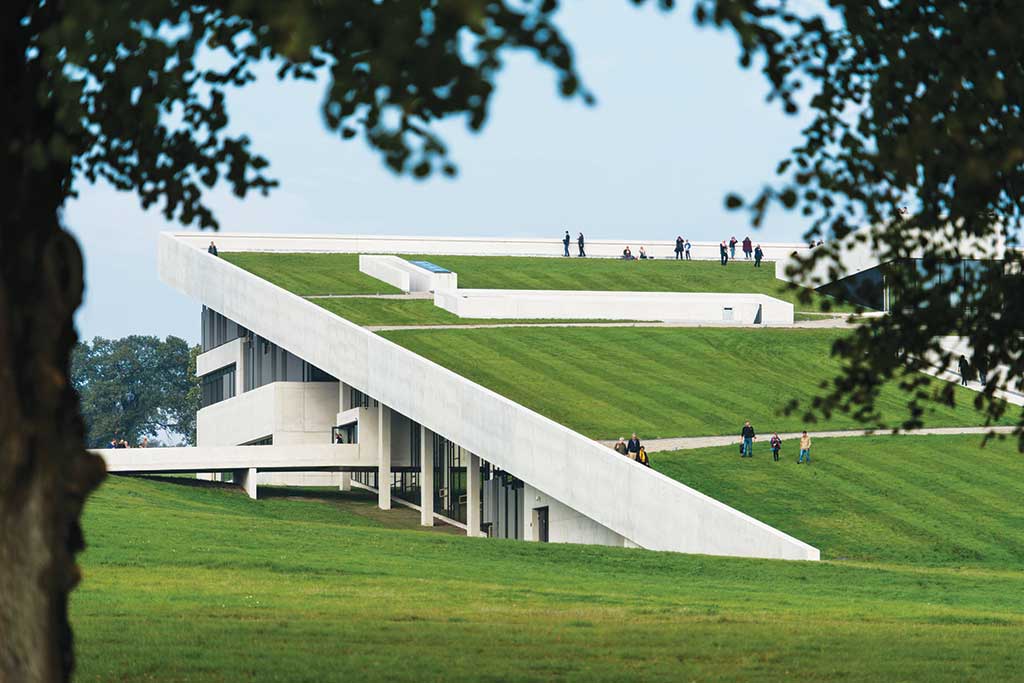

Moesgaard Museum
Denmark has been a hallmark for high-end cuisine for more than a decade, spearheaded by superstar chef René Redzepi who transformed the New Nordic food movement with the opening of noma in 2004. His culinary roots have spread far and wide with a slew of former noma chefs and other culinary luminaries setting up shop in Aarhus. The city currently has four Michelin-star restaurants, including the country-inspired Gastromé (Rosensgade 28. Tel: +45-2878-1617, www.gastrome.dk), helmed by Søren Jakobsen and William Jørgensen. Their locally sourced, seasonal menu is in sync with Michelin standards: beautiful presentation, ingredients that shine in their simplicity, and a hygge environment in which you wish you could live out the rest of your days. Tasting menus include half throttle (five courses, € 84), full throttle (eight courses, € 126), and signature (13 courses, € 352 including wine). A recent dining experience began with a snack of cold smoked beef with crème fraiche, followed by forest-cured ham with gherkins and artichoke; halibut confit with Jerusalem artichoke and watercress; French quail with chanterelle mushrooms and yellow beets; and two desserts, one of which highlighted a bizarrely refreshing dill granita.
It doesn’t require top dollar to get in on the action, though. Aarhus and Denmark’s central region have been named the 2017 European Region of Gastronomy (www.danishfoodregion.eu) and events for all budgets have been planned throughout the year. When you’ve tired of smørrebrød (the traditional open-faced sandwiches found throughout Scandinavia), turn to Aarhus Street Food (Banegaardsplads 46, www.aarhusstreetfood.com), which recently converted a massive bus hanger and parking garage into an international food hall. Here, you can find everything from banh mi, shawarma, and tacos to curries. To bring a taste of Denmark home, be sure to stop by Landmad (Kannikegade 30. Tel: +45-8622-8584. www.landmad.dk) for dry goods, confectioneries, and kitchenwares.
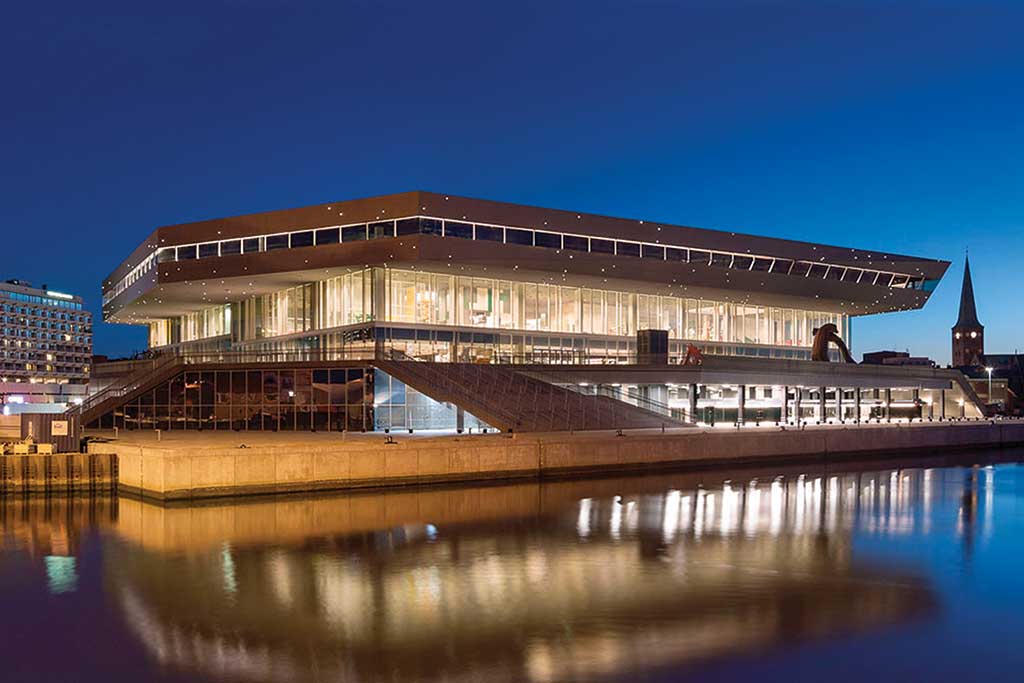

Dokk1 library
Like much of northern Europe, the LGBT scene is integrated into the various nightlife options available in Aarhus. Samesex activity has been legal since 1933, though it took until 2012 for gay marriage to get on the books. Gbar (Skolegade 28. www.gbar.dk) draws a diverse crowd, but plan on a late night as things don’t pick up until after midnight and weekend parties can carry on until 5 A.M. SLM Aarhus (Østbanetorvet 8. www.slmaarhus.dk) describes itself as “Jutland’s only club for men who are men—with a focus on the masculine expression.” Membership is required to enter (a guest pass is available for 50kr), with most nights focusing on various fetish themes that include leather, uniform, sport, and underwear. With a history dating back to 1978, SLM currently has more than 600 members.
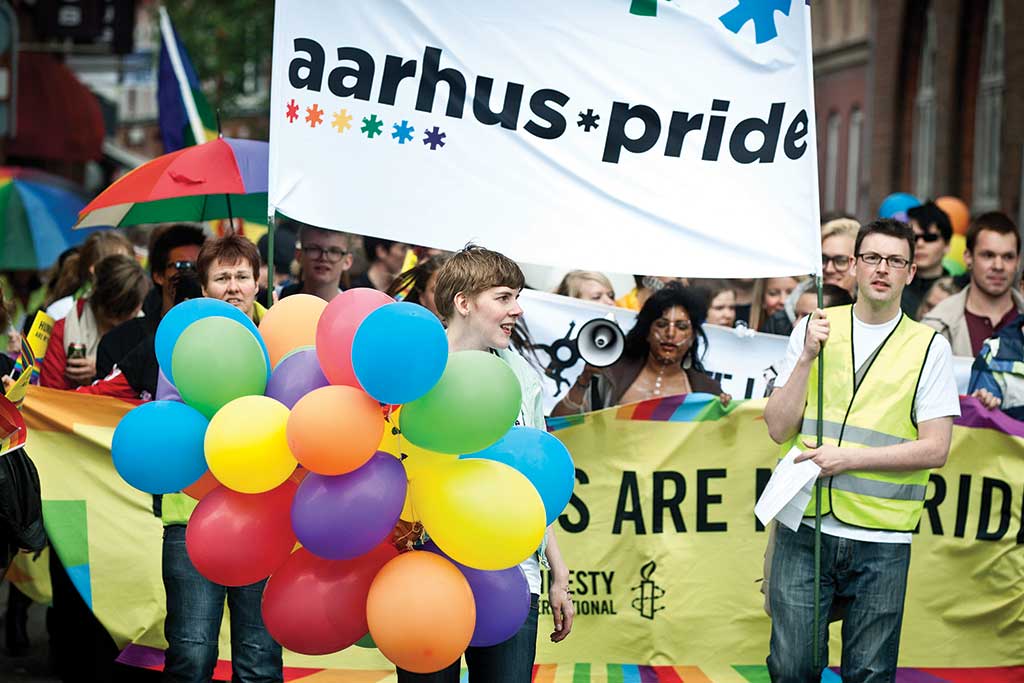

This year, Aarhus celebrates its fifth annual Pride (www.aarhuspride.dk) with an expected crowd of 5,000 participants and a much larger number of spectators on June 3. “The special thing about Aarhus Pride is the cozy atmosphere created by the walking parade without floats,” says Aarhus Pride Chairperson Mads Hedelund. “The idea behind this is to show and celebrate diversity eye to eye with the spectator and the general public. Street food and Nordic gastronomy are popular trends in Denmark at the moment and Aarhus Pride also organized a large street food fair at the Pride Square, which is at the end of the Pride parade.”
Whether it’s a rainbow of revelry during Pride, or a cornucopia of cuisine and culture that has elevated Aarhus to international acclaim, a jaunt to Jutland is a must to make your next journey to Denmark complete.
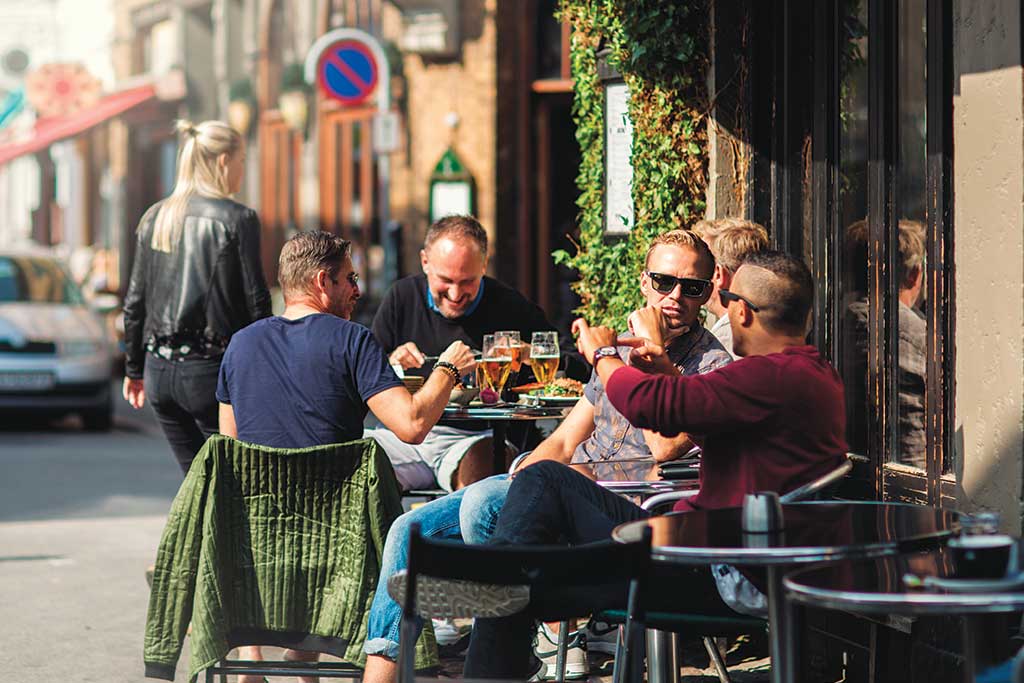

Drenge på café i Latinerkvarteret
TRAVEL ESSENTIALS
Getting There:
Norwegian Air (www.norwegian.com) is the most awarded long-haul low-cost carrier and fastest growing airline in the world, with direct flights from New York, Boston, Miami, Las Vegas, and Los Angeles.
Where to Stay:
Scandic Aarhus City (Østergade 10, Tel: +45-8931-8100, www.scandichotels.com) is a four-star hotel that operates primarily on solar power, offering neutral furnishings with pops of jewel tones and free bicycles to explore the city.
Day Trip:
Head to Molskoren (Hovedgaden 16, Femmøller Strand, Tel: +45-8636-2200, www.molskroen.dk), an exquisite and luxurious seaside inn that overlooks the Bay of Ebeltoft Vig featuring an inspired restaurant helmed by chef Steffen Villadsen.


